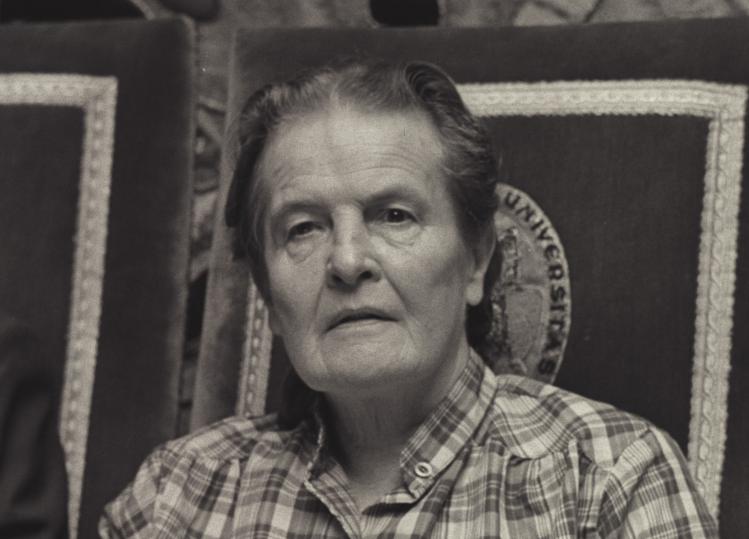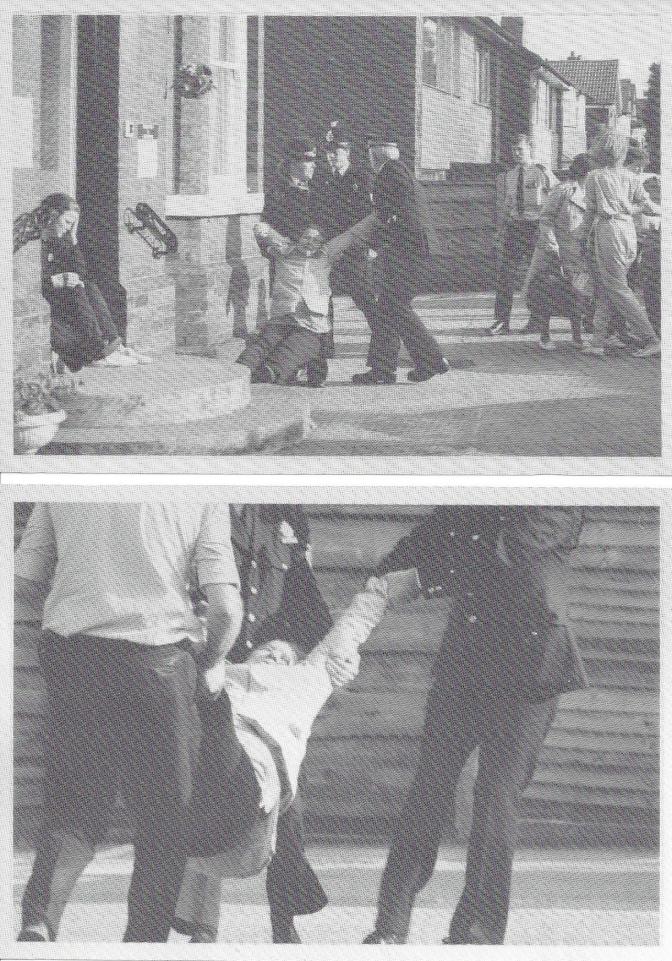
Today marks the centenary of the birth of Gertrude Elizabeth Margaret Anscombe, one of the most brilliant and influential Catholic philosophers of the twentieth century.
Anscombe was born in Ireland to a Welsh-English family. She converted to Catholicism as a teenager, then attended the University of Oxford from 1937 to 1941. In 1939, she and her friend Norman Daniels cowrote a pamphlet opposing Britain’s entry into the Second World War, arguing among other things that the prospect of an air attack on civilian populations meant that the conduct of the war would violate the traditional prohibition on adopting unjust means of victory. In her contribution to the pamphlet, Anscombe wrote that “unjust deliberate killing is murder and this is a great sin which ‘cries out to heaven for vengeance’”:
[I]f, therefore, the warring state intends, under any circumstances, to commit it as a means of prosecuting the war, then the war is made wicked. As we have seen, our present government does intend to do that which is unlawful…. The present war is therefore wrong on account of means.
The British government declared war on Nazi Germany shortly thereafter, and prosecuted the war through the deliberate killing of German and Japanese civilians. Meanwhile, the Roman Catholic Archbishop of Birmingham had Anscombe and Daniels withdraw their pamphlet, since they had distributed it without getting a church license.
While at Oxford, Anscombe met her future husband and fellow philosopher Peter Geach, whose death I noted in this space in 2013. Together they would have seven children.
In 1942 Anscombe moved to the University of Cambridge on a research fellowship, where she met Ludwig Wittgenstein and began to attend his lectures. Ray Monk’s biography of Wittgenstein, The Duty of Genius, describes how she was initiated into his inner circle:
By the end of the year [1946–1947, when Anscombe was attending Wittgenstein’s tutorials while a research student at Oxford] she had become one of Wittgenstein’s closest friends and one of his most trusted students, an exception to his general dislike of academic women and especially of female philosophers. She became, in fact, an honorary male, addressed by him affectionately as “old man.”
A letter that Wittgenstein wrote in 1945 for Anscombe’s application to her fellowship at Oxford, which philosophers circulated on Twitter this time two years ago, described her as “the most talented female student I have had since 1930, when I began to lecture”—before adding that “among my male students only eight, or ten have equaled or surpassed her.”
In 1956, Anscombe caused a major controversy by opposing the University of Oxford’s decision to award an honorary doctorate to former U.S. President Harry Truman. A pamphlet that she wrote to explain her opposition to the degree argued that his decision to bomb the cities of Hiroshima and Nagasaki meant that Truman was nothing short of a murderer, and “murder is one of the worst of human actions”:
Choosing to kill the innocent as a means to your ends is always murder. Naturally, killing the innocent as an end in itself is murder too; but that is no more than a possible future development for us: in our part of the globe it is a practice that has so far been confined to the Nazis. I intend my formulation to be taken strictly; each term in it is necessary. For killing the innocent, even if you know as a matter of statistical certainty that the things you do involve it, is not necessarily murder. I mean that if you attack a lot of military targets, such as munitions factories and naval dockyards, as carefully as you can, you will be certain to kill a number of innocent people; but that is not murder. On the other hand, unscrupulousness in considering the possibilities turns it into murder.
Despite the clarity of her argument, Anscombe’s effort to block the degree proved to be in vain—there were only four total votes in favor of her motion, and she later recalled her (male) colleagues at St. John’s College being recruited to vote against her measure simply on the grounds that “the women are up to something in the Convocation: we have to go and vote them down.” She did, however, generate enough of a controversy to warrant a pair of short articles in the New York Times, one of which mistakenly identified the “woman tutor” behind the objection as being named “Gladys.”
As the quotation above makes clear, Anscombe’s argument that Truman was a murderer presupposed that we can distinguish between killing someone as a means to an end and killing someone as a foreseen but unintended side effect of something that one intentionally does. For many of her colleagues in philosophy, this distinction seemed difficult to sustain. In 1874, the philosopher Henry Sidgwick argued in the influential book The Methods of Ethics that a person’s intentional actions do include “the effects which he foresaw in willing the act”—which would mean that civilians killed in attacks on military targets are killed intentionally no less than were the citizens of Hiroshima and Nagasaki. Similarly, in his 1952 book The Language of Morals, Anscombe’s Oxford colleague R. M. Hare argued that what matters in action is simply “the effects on the total situation” of whatever one does:
It is the effects which determine what I should be doing; it is between the two sets of effects that I am deciding. The whole point about a decision is that it makes a difference to what happens; and this difference is the difference between the effects of deciding one way, and the effects of deciding the other.
Anscombe’s classic paper “Modern Moral Philosophy,” written in 1956, identified this picture of intention and intentional action as the root of the consequentialism that Oxford moral philosophers had come to take for granted. According to this view, “a man does well, subjectively speaking, if he acts for the best in the particular circumstances according to his judgment of the total consequences of this particular action.” As Anscombe saw, consequentialism makes it impossible to conceive of things that one should absolutely never do, no matter the circumstances. For it will always be possible to imagine circumstances in which doing a thing of such-and-such a sort—such as annihilating a city full of innocent civilians—will have better consequences than refraining from doing so. This, she observed in “Modern Moral Philosophy,” made Oxford consequentialism “quite incompatible with the Hebrew-Christian ethic”:
For it has been characteristic of that ethic to teach that there are certain things that are forbidden whatever consequences threaten, such as choosing to kill the innocent for any purpose, however good; vicarious punishment; treachery…; idolatry; sodomy; adultery; making a false profession of faith.
In her 1957 book Intention, now regarded as the foundational text in analytic philosophy of action, Anscombe attempted a Wittgensteinian defense of the understanding of intention that philosophers like Sidgwick and Hare had ruled out. She was also arguing there against a view of intention that had become popular among Catholic moral theologians. Her 1961 paper “War and Murder” described this view as resting on a form of “Cartesian psychology”:
According to this psychology, an intention was an interior act of the mind which could be produced at will. Now if intention is all important—as it is—in determining the goodness or badness of an action, then, on this theory of what intention is, a marvelous way offered itself of making any action lawful. You only had to “direct your intention” in a suitable way. In practice, this means making a little speech to yourself: “What I mean to be doing is…”
This view is “nonsense,” Anscombe said—but not because there is no distinction at all between intending to do something and merely foreseeing that one will do it. The task of Intention was to work out a view that avoided these opposite errors.
Many of Anscombe’s other ethical writings attempted to show how a correct understanding of what an intentional action is could reveal the coherence of, and justification for, some of the other traditional “Hebrew-Christian” prohibitions named above. In each case her position was uncompromisingly orthodox, defending positions that would offend both sides of today’s liberal/conservative divide. In “Contraception and Chastity” (1972), she defended the position of Paul VI’s encyclical Humanae vitae against the use of contraceptives. A paper from 1970, titled “Philosophers and Economists: Two Philosophers’ Objections to Usury,” argued that it is wrong to charge interest on loans. And a paper from the late 1970s condemns “simony”—the practice of refusing to baptize a child except on payment of a sum of money to the priest. (All these papers are included in the posthumous collection Faith in a Hard Ground, which includes many of the essays Anscombe wrote for a more popular audience.) Nor was her opposition to these practices merely theoretical: she was arrested twice for blocking the door of an abortion clinic as part of an Operation Rescue effort.

One of the things that will likely strike the reader who turns to these essays is the unflinching confidence and literalness with which Anscombe articulates and defends traditional Christian doctrine. Her teacher Wittgenstein is a likely influence here: he insisted that in doing philosophy we should avoid falling back on abstractions and technical jargon, and should put things instead in words that could be at home in everyday life. Anscombe’s brilliant essay “On Transubstantiation,” published by the Catholic Truth Society in 1974, showed what it would be to take this approach in the way we speak about the Eucharist:
It is easiest to tell what transubstantiation is by saying this: little children should be taught about it as early as possible. Not of course using the word “transubstantiation,” because it is not a little child's word. But the thing can be taught, and it is best taught at Mass at the consecration, the one part where a small child should be got to fix its attention on what is going on. I mean a child that is beginning to speak, one that understands enough language to be told and to tell you things that have happened and to follow a simple story. Such a child can be taught then by whispering to it such things as: “Look! Look what the priest is doing…. He is saying Jesus’ words that change the bread into Jesus’ body. Now he’s lifting it up. Look! Now bow your head and say ‘My Lord and my God,’” and then “Look, now he’s taken hold of the cup. He’s saying the words that change the wine into Jesus’ blood. Look up at the cup. Now bow your head and say “We believe, we adore your precious blood, O Christ of God.” This need not be disturbing to the surrounding people. If the person who takes a young child to Mass always does this (not otherwise troubling it), the child thereby learns a great deal.
This is still good advice, and admirably expressed. And anyone who has read Anscombe’s work will recognize her voice: direct, unaffected, uncompromising and perhaps a little severe, but finally reassuring. It was the voice of someone who spent her life trying to deliver the truth from obscurity, even—or perhaps especially—when the truth was inconvenient.


